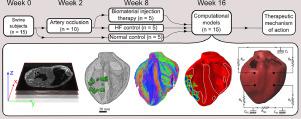Acta Biomaterialia ( IF 9.7 ) Pub Date : 2020-05-16 , DOI: 10.1016/j.actbio.2020.04.033 Kevin L Sack 1 , Eric Aliotta 2 , Jenny S Choy 3 , Daniel B Ennis 2 , Neil H Davies 4 , Thomas Franz 5 , Ghassan S Kassab 3 , Julius M Guccione 6

|
Despite positive initial outcomes emerging from preclinical and early clinical investigation of alginate hydrogel injection therapy as a treatment for heart failure, the lack of knowledge about the mechanism of action remains a major shortcoming that limits the efficacy of treatment design. To identify the mechanism of action, we examined previously unobtainable measurements of cardiac function from in vivo, ex vivo, and in silico states of clinically relevant heart failure (HF) in large animals. High-resolution ex vivo magnetic resonance imaging and histological data were used along with state-of-the-art subject-specific computational model simulations. Ex vivo data were incorporated in detailed geometric computational models for swine hearts in health (n = 5), ischemic HF (n = 5), and ischemic HF treated with alginate hydrogel injection therapy (n = 5). Hydrogel injection therapy mitigated elongation of sarcomere lengths (1.68 ± 0.10μm [treated] vs. 1.78 ± 0.15μm [untreated], p<0.001). Systolic contractility in treated animals improved substantially (ejection fraction = 43.9 ± 2.8% [treated] vs. 34.7 ± 2.7% [untreated], p<0.01). The in silico models realistically simulated in vivo function with >99% accuracy and predicted small myofiber strain in the vicinity of the solidified hydrogel that was sustained for up to 13 mm away from the implant. These findings suggest that the solidified alginate hydrogel material acts as an LV mid-wall constraint that significantly reduces adverse LV remodeling compared to untreated HF controls without causing negative secondary outcomes to cardiac function.
Statement of Significance
Heart failure is considered a growing epidemic and hence an important health problem in the US and worldwide. Its high prevalence (5.8 million and 23 million, respectively) is expected to increase by 25% in the US alone by 2030. Heart failure is associated with high morbidity and mortality, has a 5-year mortality rate of 50%, and contributes considerably to the overall cost of health care ($53.1 billion in the US by 2030). Despite positive initial outcomes emerging from preclinical and early clinical investigation of alginate hydrogel injection therapy as a treatment for heart failure, the lack of knowledge concerning the mechanism of action remains a major shortcoming that limits the efficacy of treatment design. To understand the mechanism of action, we combined high-resolution ex vivo magnetic resonance imaging and histological data in swine with state-of-the-art subject-specific computational model simulations. The in silico models realistically simulated in vivo function with >99% accuracy and predicted small myofiber strain in the vicinity of the solidified hydrogel that was sustained for up to 13 mm away from the implant. These findings suggest that the solidified alginate hydrogel material acts as a left ventricular mid-wall constraint that significantly reduces adverse LV remodeling compared to untreated heart failure controls without causing negative secondary outcomes to cardiac function. Moreover, if the hydrogel can be delivered percutaneously rather than via the currently used open-chest procedure, this therapy may become routine for heart failure treatment. A minimally invasive procedure would be in the best interest of this patient population; i.e., one that cannot tolerate general anesthesia and surgery, and it would be significantly more cost-effective than surgery.
中文翻译:

心肌内藻酸盐水凝胶注射充当猪的左心室中壁约束。
尽管藻酸盐水凝胶注射疗法治疗心力衰竭的临床前和早期临床研究出现了积极的初步结果,但缺乏对作用机制的了解仍然是限制治疗设计功效的主要缺点。为了确定其作用机制,我们对大型动物临床相关心力衰竭 (HF) 的体内、离体和计算机状态进行了以前无法获得的心脏功能测量。使用高分辨率离体磁共振成像和组织学数据以及最先进的特定于主题的计算模型模拟。将离体数据纳入健康猪心脏 ( n = 5)、缺血性心力衰竭 ( n = 5) 和海藻酸盐水凝胶注射疗法治疗的缺血性心力衰竭 ( n = 5) 的详细几何计算模型中。水凝胶注射疗法减轻了肌节长度的延长(1.68 ± 0.10μm [治疗] vs. 1.78 ± 0.15μm [未治疗],p <0.001)。治疗动物的收缩力显着改善(射血分数 = 43.9 ± 2.8% [治疗] vs. 34.7 ± 2.7% [未治疗],p<0.01)。计算机模型以 >99% 的准确度真实地模拟了体内功能,并预测了固化水凝胶附近的小肌纤维应变,该应变持续距离植入物长达 13 毫米。这些发现表明,固化的藻酸盐水凝胶材料作为左心室中壁约束,与未经治疗的心力衰竭对照组相比,可显着减少不利的左心室重塑,而不会对心功能造成负面的次要结果。
重要性声明
心力衰竭被认为是一种日益严重的流行病,因此是美国和全世界的一个重要的健康问题。其高患病率(分别为 580 万和 2300 万)预计到 2030 年仅在美国就会增加 25%。心力衰竭与高发病率和死亡率相关,5 年死亡率为 50%,并造成相当大的影响。医疗保健总成本(到 2030 年美国将达到 531 亿美元)。尽管藻酸盐水凝胶注射疗法治疗心力衰竭的临床前和早期临床研究出现了积极的初步结果,但缺乏有关作用机制的知识仍然是限制治疗设计功效的主要缺点。为了了解作用机制,我们将猪的高分辨率离体磁共振成像和组织学数据与最先进的特定主题计算模型模拟相结合。计算机模型以 >99% 的准确度真实地模拟了体内功能,并预测了固化水凝胶附近的小肌纤维应变,该应变持续距离植入物长达 13 毫米。这些发现表明,固化的藻酸盐水凝胶材料充当左心室中壁约束,与未经治疗的心力衰竭对照相比,可显着减少不利的左室重构,而不会对心功能造成负面的次要结果。此外,如果水凝胶可以经皮输送,而不是通过目前使用的开胸手术,那么这种疗法可能会成为心力衰竭治疗的常规疗法。微创手术最符合该患者群体的利益;即不能耐受全身麻醉和手术的患者,但它比手术的成本效益要高得多。


























 京公网安备 11010802027423号
京公网安备 11010802027423号